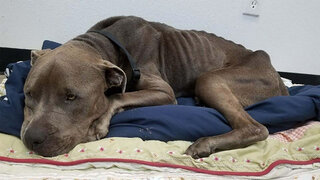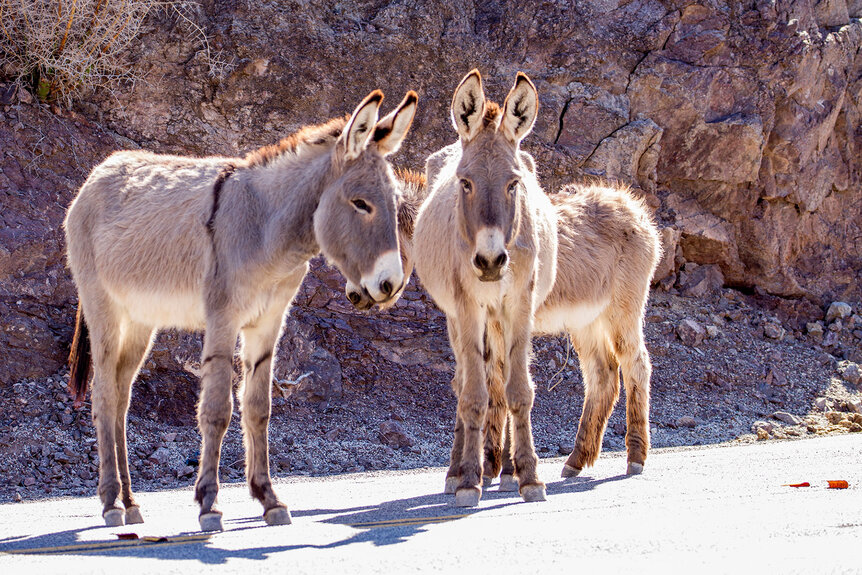Create a free profile to get unlimited access to exclusive videos, breaking news, sweepstakes, and more!
Authorities Search For ‘Savage’ Wild Donkey Killer Terrorizing Mojave Desert
A conservationist said that the killings constitute "an attack on what a lot of people hold dear."
California authorities are searching for someone who has been gunning down wild donkeys in the Mojave Desert.
Since May, 42 dead donkeys have turned up with gunshot wounds in “various states of decomposition” along the Interstate 15 corridor between Halloran Springs, California, and Primm, Nevada, according to an online statement posted by the Bureau of Land Management.
Officials said the wild donkeys, known as ‘burros,’ were killed by a sniper, who has been poaching the protected animals from a distance with a rifle. Bureau of Land Management authorities, who are leading the investigation, have partnered with animal advocacy groups, and together, they're offering a nearly $60,000 reward for information leading to the arrest of the unknown animal killer.
“The person or persons appear to be shooting at the burros from a distance,” Sarah Webster, a spokesperson for the conservation agency, told Oxygen.com. “They are shooting at their necks.”
Webster noted that many of the donkeys had been shot while grazing or drinking water. She said the killings appear to be random.
Several other law enforcement agencies, including the California Department of Wildlife and Fish, San Bernardino Sheriff’s Department, and state highway patrol, are also investigating the killings. But, so far, law enforcement has little information on a potential suspect.
“That’s the million-dollar question,” Webster added. “That’s the information we’re trying to find.”
The wild donkey killer could face up to 42 years in federal prison, Bureau of Land Management officials said — one year for every burro that’s been shot and killed. They could also be fined up to $84,000.
“We will pursue every lead until we’ve arrested and prosecuted those responsible for these cruel, savage deaths, and we welcome the public’s help to bring the perpetrator or perpetrators to justice,” William Pendley, deputy director for policy and programs at the Bureau of Land Management, said in a release.
Webster, the Bureau of Land Management spokesperson, described the killings as “heinous.”
“Wild burros by nature are very docile and approachable,” she stated. “They’re not afraid of public interaction. They’re shooting at easy targets.”
“[It’s] pretty brutal,” Jason Lutterman, a spokesperson for the conservation authority’s Wild Horse and Burro Program, also told Oxygen.com. “We never want to see anything like this happening to our wild horses and burros. You have to be a special kind of person to be able to shoot a helpless animal like that for no apparent reason. It’s a sad thing to see their lives ended so abruptly like this.”
The killings have also struck a nerve among Californians, who revere wild burros as a symbol of the state’s identity and pioneer past.
“These animals helped settle the west,” Lutterman explained.
“They helped build what we now benefit from out here. They helped build our country up here. These are the descendants of those animals. A lot of people prize them as sort of icons of the pioneer past. I think a lot of people rely on these animals as sort of defining their identity of living in the southwest part of the country, in the desert, where these animals live. It’s an attack on what a lot of people hold dear.”
The Golden State has the second-highest burro population in the U.S. with an estimated 5,000 residing on protected lands in the state, according to recent data published by the Bureau of Land Management. As of March, there were just 16,000 burros left in the U.S., with the majority residing in Arizona.
The Wild Free-Roaming Horses and Burros Act, passed in 1971, federally protects burros and wild horses from capture, abuse, or death. But according to the Los Angeles Times, it’s not the first time donkey corpses have piled up in California. In the 1950s, there were also reports of mass burro killings.
“They weren’t protected they didn't’ have any kind of legal status,” Lutterman added. “These kinds of events were probably a lot more common.”
Lutterman explained that the donkeys are descendants of locally domesticated species, noting that the free-roaming animals aren’t technically endangered. He said that while his agency has seen random killings of burros in the past, he’s never seen anything “on this scale” in his career.



























